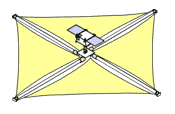LightSail-1
LightSail-1 is a solar sail project scheduled for launch in April 2016 and developed by the Planetary Society, a global non-profit organization devoted to space exploration.[1] The kite-shaped spacecraft, which was announced in 2009, will have a total cross-section of 32 square meters (340 sq ft), and will be fitted with guidance and diagnostic electronics. If the project is successful, two more solar sails, LightSail-2 and LightSail-3, will be built.[2]
Development

In 2005, the Planetary Society attempted to send its first solar sail, Cosmos 1, into orbit, but the Russian Volna launch vehicle failed to reach orbit.[3] In 2009, the Society took over NASA's NanoSail-D project, which they later renamed LightSail.[4] Nanosail-D had failed to attain orbit in August 2008 due to the failure of its Falcon 1 launch vehicle. (A backup, NanoSail-D2, was successfully deployed in early 2011.)
In November 2009, the Society announced in Washington D.C. that it would build and launch LightSail-1.[4] By 2011, the project had passed its critical design review, which was conducted by a team including JPL project veterans Bud Schurmeier, Glenn Cunningham, and Viktor Kerzhanovich, as well as Dave Bearden of Aerospace Corporation.[2] The estimated cost of LightSail-1 was US$1.8 million, which was raised from membership dues and private sources. The spacecraft was built in San Luis Obispo by Stellar Exploration Inc.[3]
Design
As a solar sail, LightSail-1's propulsion is dependent on solar radiation alone. Infalling photons will exert radiation pressure on the sail, producing a small degree of acceleration. Thus, the solar sail will be propelled by pressure from sunlight itself, and not by the charged particles of the solar wind.[5] Although the acceleration is expected to be slow, it will be continuous, permitting LightSail-1 to reach relatively high speeds over time.[3][4]

Structure
LightSail-1 has four triangular sails, which combine to form a rectangular-shaped surface. The spacecraft will be packed into a 3-litre volume for launch, and will unfold to its full size upon reaching orbit. The sails are made of Mylar, a reflective polyester film, and they have an area of 32 square meters, which would make the craft easily visible to naked-eye observers on Earth.[6]
LightSail-1's modular design will be based on a three-unit CubeSat, a small satellite created for university-level space projects. One CubeSat unit will carry the cameras, sensors and control systems, while the other two units will contain the solar sails.[7]
Mission
LightSail-1's goal is to test if solar sails are a viable form of space transport. The theory will be tested by measuring if there is any increase in LightSail-1's orbital speed once the spacecraft is released at an altitude of 500 miles (800 km).[7] The Planetary Society originally hoped to launch LightSail-1 in 2012,[8] but in 2014 announced that it is scheduled for launch in April 2016.[1]
An initial test launch of the LightSail spacecraft is scheduled for May 2015.[9] This launch will deliver the satellite to an orbit low enough that atmospheric drag exceeds the thrust available from the light sail, but will allow a full checkout of the satellite's systems in advance of the main 2016 mission.[10]
Future projects
If LightSail-1 is successful, then the Planetary Society will execute two more solar sail projects with more complex goals. LightSail-2's goal will be to collect scientific data and improve solar sailing control. LightSail-3's goal would be to travel to the L1 Lagrangian point. There, it would be used to detect geomagnetic storms on the Sun, which can damage power and communication systems on Earth and orbiting spacecraft. Such detection will provide earlier warnings of potential power failures.[4][7]
See also
- IKAROS, a Japanese solar sail, launched in May 2010
- NanoSail-D2, the successor to NanoSail-D, launched in November 2010
References
- ↑ 1.0 1.1 Davis, Jason (10 July 2014). "LightSail update: Launch dates". The Planetary Society. Retrieved 10 July 2014.
- ↑ 2.0 2.1 Louis D. Friedman (June 25, 2010). "LightSail-1 Passes Critical Design Review". The Planetary Society.
- ↑ 3.0 3.1 3.2 Antczak, John (November 9, 2009). "After letdown, solar-sail project rises again". MSNBC. Associated Press.
- ↑ 4.0 4.1 4.2 4.3 Dennis Overbye (November 9, 2009). "Setting Sail Into Space, Propelled by Sunshine". The New York Times.
- ↑ "Planetary Society To Sail Again With LightSail". Space Travel blog. November 10, 2009.
- ↑ "LightSail Has a Launch Date!". The Planetary Society.
- ↑ 7.0 7.1 7.2 "LightSail-1". The Planetary Society.
- ↑ "NASA to test new solar sail technology". Universe Today. 13 October 2011. Retrieved 2011-10-29.
- ↑ Davis, Jason (April 13, 2015). "LightSail Launch Delayed until at least May 20". The Planetary Society.
- ↑ Davis, Jason (January 26, 2015). "It's Official: LightSail Test Flight Scheduled for May 2015". The Planetary Society.
| ||||||||||||||